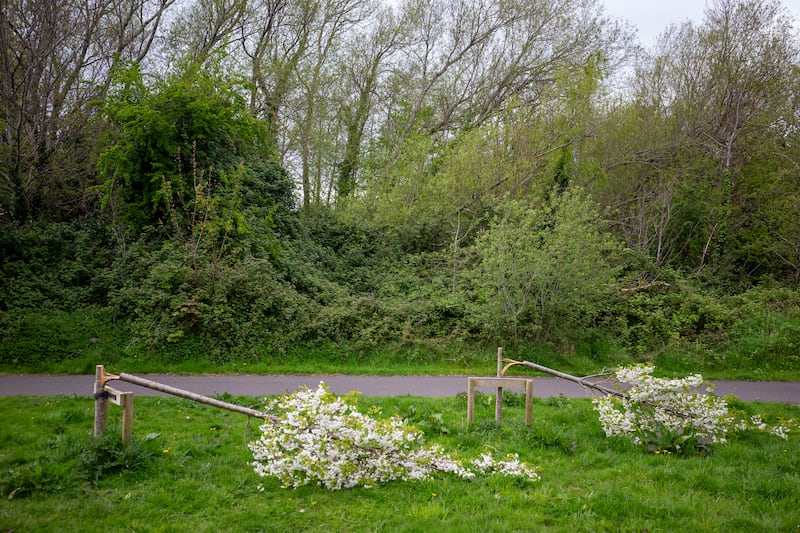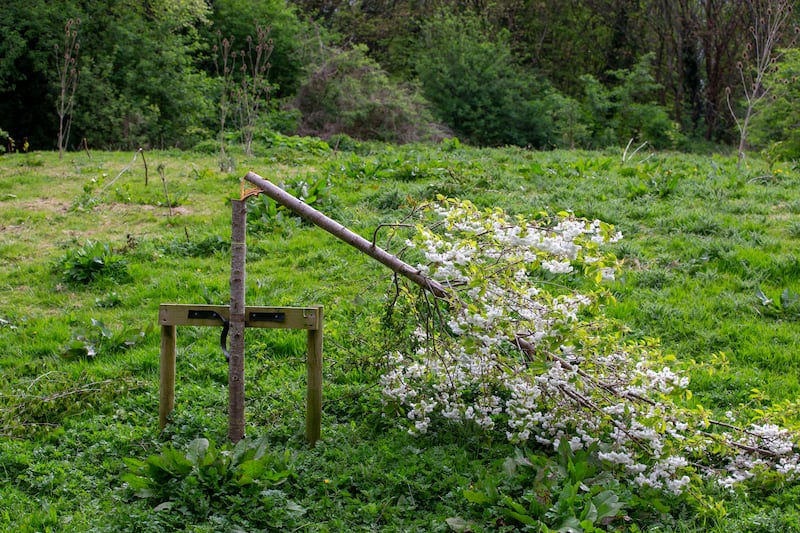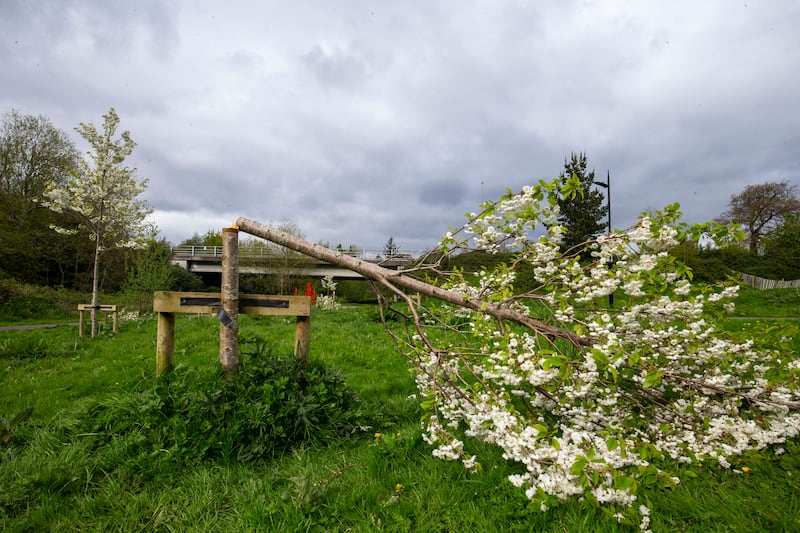“We only conserve what we love; we only love what we understand and we only understand what we are taught.”
This quote, which is variously attributed to French underwater explorer Jacques-Yves Cousteau and Senegalese conservationist Baba Dioum, may give cold comfort to Firhouse residents who are distraught following the destruction of more than 20 cherry blossom trees and about 50 native tree saplings in Dodder Valley Park in south Dublin late last week.
And while locals – and nature lovers everywhere – remain “bewildered” following the incident, according to South Dublin County Council’s mayor Alan Edge, we need to understand what prompts a small number of people to wantonly destroy beautiful trees in full bloom before we can learn how to stop this type of nature vandalism from occurring more frequently.
“I don’t know if you can safeguard against these things happening. It could be one or two people and it’s probably somebody who isn’t doing well emotionally,” says Neasa Ní Bhriain, director of A Playful City, a not-for-profit organisation working with communities to create more playful, healthy and inclusive public spaces.
RM Block

‘You’ve got to ask various groups – the Men’s Shed, senior gardening groups, afterschool groups, creches – how they want to use that space and then you have more eyes on it’
— Neasa Ní Bhriain, director of A Playful City, a not-for-profit organisation
Ní Bhriain believes the best way to keep public spaces safe and free from vandalism is to involve many people in that community in their use. “You’ve got to ask various groups – the Men’s Shed, senior gardening groups, afterschool groups, creches – how they want to use that space and then you have more eyes on it. Creating events within parks is the best way to keep them busy and with that comes passive surveillance,” she says.

Even having a tangential connection to a public space – for example, if your son, sister or father helped plant a tree there – might prevent some people from defacing or destroying public spaces, but it would be naive to suggest that community involvement can completely eliminate the problem.
[ Community shocked by destruction of trees in Dublin parkOpens in new window ]
In Firhouse, it is believed that a battery-powered electric saw was used to cut through most of the trunks before they were forced over and snapped, causing irreparable damage. The cost of the damage is thought to be about €33,000. And this is the second such attack in Dodder Valley Park; in April 2023 about eight trees were cut down deliberately at the other end of the park.
South Dublin County Council had CCTV installed in the past to monitor antisocial behaviour. However, following a data protection audit, the council was obliged to remove it.
The bullaun stone (also known as the Deerstone) in Glendalough was set on fire in 2023, resulting in large cracks in the 1,000-year-old granite boulder
Ní Bhriain also suggests that when something does happen, it’s important not to speculate and cast views on who might have done it. “Often, you hear people say that young loitering teenagers are the ones who do things, but that’s unfair,” she says. Readers may remember that a 50-year-old man was jailed earlier this year for damaging the Sheriff Street statue of the late Dubliners’ singer Luke Kelly in 2020.
[ Residents ‘devastated’ after 40 trees cut down or broken overnight in Dublin parkOpens in new window ]
Virginia Teehan, chief executive of the Heritage Council, says that wilful damage to natural or built heritage is a “public expression of anger”. “When people feel discontented and angry or dissatisfied with something in society, they lash out in rage,” she says.
There have been several incidents where local heritage sites have been vandalised in recent years. These include damage to Loughcrew cairns, the Neolithic burial monument near Oldcastle, Co Meath, when graffiti was etched across passage tombs. The bullaun stone (also known as the Deerstone) in Glendalough was set on fire in 2023, resulting in large cracks in the 1,000-year-old granite boulder.
Teehan acknowledges the role of the National Parks and Wildlife Service (NPWS) and the National Monuments Service (NMS) in imposing fines and taking legal action against perpetrators of damage to public green spaces and monuments. But she says that “looking earlier to see how to win hearts and minds” is also important.
She cites the Adopt a Monument scheme, where the Heritage Council supports people to look after a local historical site, as a pertinent example. “This scheme gives people a sense of pride and belonging to their area”, she says, referencing one particular heritage site in Co Waterford that had a history of being vandalised. “By engaging with this motte and bailey [a medieval system of defence in which a stone tower on a mound is surrounded by an area of land], that community changed the dynamics of the area,” she said.
[ Molly Malone statue vandalised for third time in two monthsOpens in new window ]
The NPWS has recently recruited more staff to detect, prevent and enforce wildlife crimes. Forty-three prosecutions for alleged breaches of wildlife legislation were initiated by the state organisation in 2023. These included illegal hunting, unlawful destruction of vegetation in hedgerows and the disturbance of bats.

The NPWS also encourages anyone who suspects or witnesses a wildlife crime to contact their nearest NPWS conservation ranger, email the wildlife service or contact the gardaí.
‘If there is any silver lining, actually the fact that people were coming together and almost commiserating with each other is a sign of how far we have moved on as a county and community here’
— Alan Edge, mayor of South Dublin County Council
Speaking at the announcement of increased successful prosecutions for breaches of the Wildlife Acts for 2023, Minister of State with responsibility for Nature and Heritage Malcolm Noonan described citizen reporting as an “essential element in safeguarding nature”.
Unfortunately, the residents of Firhouse can only look back in horror at the deliberate destruction of trees in a park in which community groups and the local authority have planted thousands of trees in the last five years.
Caragh Coote, a volunteer with the Dodder Action Group, which monitors the welfare of the river flowing through the park, said earlier this week: “It’s just devastating to all of us who have put so much time into their beautiful park.” The popular Dodder Greenway also passes through the park.
Meanwhile, mayor Alan Edge said: “If there is any silver lining, actually the fact that people were coming together and almost commiserating with each other is a sign of how far we have moved on as a county and community here. People really do feel the loss of these trees very, very deeply.”
- Sign up for push alerts and have the best news, analysis and comment delivered directly to your phone
- Find The Irish Times on WhatsApp and stay up to date
- Listen to our Inside Politics podcast for the best political chat and analysis






















